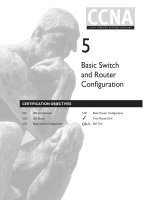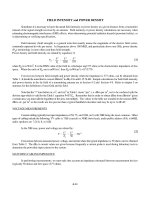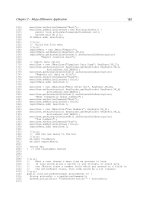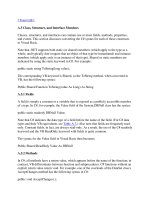Tài liệu Guided Reading and Spanish-Speaking Children doc
Bạn đang xem bản rút gọn của tài liệu. Xem và tải ngay bản đầy đủ của tài liệu tại đây (280.13 KB, 12 trang )
Guided Reading and
Spanish-Speaking Children
by
Enrique Puig
en español
1
INTRODUCTION
A
s the demographics of our country continue to change, more and more students
are coming into our classrooms from homes that speak a language other than
English, primarily Spanish. According to Slavin & Cheung (2004), English-
language learners comprise one of the fastest-growing student populations in U.S. schools.
Knowing these students’ strengths as well as anticipating their needs should inform the
design and delivery of literacy instruction for second-language learners (August et al.,
2002). Following are the challenges faced in bilingual classrooms and in reading
instruction for second language learners:
• Delivering differentiated instruction to a growing population of English-language
learners;
• Locating and using relevant and suitable materials to support instruction;
• Using suitable assessments to screen, monitor progress, and diagnose students in
order to inform instruction.
Equipped with a systematic and explicit instructional approach, teachers can meet these
challenges, helping students learn to read and write while respecting their first language.
A clear and proven approach will assist teachers in making informed decisions about how
to differentiate instruction and offer suitable challenges within students’ instructional
range. The guided reading instructional system provides the appropriate level of text and
instructional support so that students can process each book with fluency and comprehension.
Providing guided reading instruction in the students’ first language establishes the
necessary scaffolding for students to become proficient learners of English. This is
accomplished by delivering reading instruction based on the students’ strongest asset—
their familiarity with their native language. Additionally, such instruction helps
students maintain their first language as well as concurrently advance their literacy skills
in both languages.
en español
Fountas & Pinnell (2001) describe guided reading as small-group instruction in which the
teacher selects a text at an appropriate level, introduces the text, and provides purposeful
teaching that supports the students’ understanding of the text. Guided
reading addresses the following key instructional issues facing teachers of English-
language learners:
1. How do we provide effective literacy development in students’ first language?
2. How do we establish the necessary scaffolding to offer appropriate support
and challenges?
3. How do we ensure that instruction relates to children’s social and cultural backgrounds?
4. How can we carefully match the characteristics of texts to readers and their grasp
of the reading process?
Whether guided reading instruction is in English or Spanish, the essential components are
the same. Providing effective reading instruction in either language depends on evaluating
the strengths and needs of the students. Torgesen (1998) recommends that in order for
teachers to obtain a complete picture of students’ overall reading development, they need
to observe students as they integrate all sources of information. This can be achieved by
observing students as they read connected text. Guided reading instruction provides an
important tool for such observation in addition to offering scaffolded instruction.
The necessity of providing a systematic approach to second-language learning is
underscored by the fact that language learning takes place most rapidly in the early years,
making it easier to learn a second-language at an earlier rather than a later age, preferably
before the age of ten (Jensen, 1998). Students within a guided reading program are
continually expanding, extending and refining their reading skills and strategies, and
through this process teachers are adding to their repertoire of instructional practices, all of
which can only serve future generations of English-language learners.
The Research Foundation
While all teachers benefit from an ongoing theoretical and research-based understanding
of their practice, in particular, Garcia (1992) found that effective teachers of second-
language learners were those who were articulate about what they were doing in the
classrooms and had specific beliefs about their roles in teaching and learning. The
following pages examine key research findings about second language learning, how these
findings are incorporated in the principles of guided reading instruction, and their specific
application in the Scholastic Guided Reading en español program.
en español
2
How do we provide effective literacy
development in students’ first language?
Research Finding: Children who are literate in a first language are able to
transfer literacy skills from their first language to a second one.
R
esearch has established that children who are literate in a first language are more readily
able to acquire literacy in a second one (Fitzgerald, 1995; Garcia, 1998). Moreover, students’
strengths in their native Spanish will assist them well in acquiring a second language. It has
been demonstrated that children who had attended school and acquired basic literacy skills in their
native language before emigrating to the United States matched their peers in reading as soon as
they gained proficiency in spoken English. Conceptual knowledge developed in one language helps
to make input in the other language comprehensible. Research by Durgunoglu, Nagy, & Hancin
(1993) concluded that there is cross-language transfer of particular literacy skills, such as phonemic
awareness skills.
In strengthening students’ native Spanish, we are actually priming them for the acquisition of a
second language. By developing students’ Spanish literacy, teachers will enable them to use their
native language well while enhancing their bilingual capabilities (August et al., 2002).
Guided Reading Principles
•
Guided reading builds on students’ overall knowledge base and strengths, and
provides them with appropriate challenges at their level.
•
Guided reading builds on students’ language knowledge, helping students apply
what they know about letters, sounds, and words.
•
Guided reading provides readers the opportunity to explore a wide range of
texts that they will be able to read.
Guided Reading en español
Strategies aimed at building literacy skills in students’ first language are taught in
Guided Reading en español through the use of Spanish-language fiction and
nonfiction leveled books. These books allow teachers to match students with the
just-right level of text, promoting implementation of phonics and word-based
strategies as well as facilitating the transition to English by establishing a
foundation in transferable comprehension, literacy, and language skills in the
context of readings in the home language.
3
en español
4
How do we establish the necessary scaffolding
to offer appropriate support and challenges?
Research Finding: Building new knowledge upon existing skills is key to
children’s language and literacy development.
W
hat the child can do with assistance today can be done alone tomorrow (Vygotsky, 1978). In
scaffolding reading instruction for the second-language learner, it is important for the teacher
to use small-group instruction and to employ the meaningful use of realia (concrete objects)
and total physical response (TPR) techniques (context-specific movements). The use of leveled texts is one
key way to differentiate instruction for Spanish-speaking students and scaffold students toward reading
independence. Teachers need to constantly monitor the progress of the students to ensure that texts,
interactions, and assignments are at the instructional level appropriate for optimum learning (Fountas &
Pinnell, 1996).
It has been widely observed that bilingual children constantly use one language to support and
develop the other language ( Jimenez, Garcia, & Pearson, 1996). For instance, the use of cognates
seems to be reciprocal between the first and second languages. When teaching English-language
reading to Spanish-speaking students, consideration must be given to the similarities and differences
in the two languages. For Spanish-speaking students, these common skills include reading from left
to right, returning to the next line at the right margin, and putting words together with the same 26
letters of the alphabet, with the exception of diacritical marks.
Attunement to differences is a strength that can be built upon for second-language learners (Hiebert,
2001). For instance, children who are learning to read in a second language have been found to be more
attuned to different sounds in the second language than monolingual children (August, Calderon, &
Carlo, 2002). In addition, successful readers have been shown to use a self-teaching strategy in which
they figure out unknown words by applying their knowledge of previously taught patterns (Share, 1995).
Guided Reading Principles
•
Guided reading instruction is conducted in small groups based on similar reading behaviors with
the teacher differentiating the instruction for each student by prompting individual students to
use specific reading strategies as needed.
•
The key phases of guided reading instruction include the introduction of vocabulary and concepts
that link to students’ experience (before reading); individual prompting, reinforcement, and teacher
demonstrations (during reading); and rich conversation and explicit skill lessons (after reading).
•
Guided reading provides the necessary support to encourage the active participation of students
with a variety of texts at their instructional level.
Guided Reading en español
Guided Reading en español is designed to teach to the widest range of reading abilities
that exist in K–3 classrooms. The comprehensive instructional plans provide
scaffolded instruction for each carefully leveled book. Every lesson provides
instruction that addresses phonemic awareness, phonics, vocabulary, fluency, and
comprehension in order for students to become independent strategic readers. Each
Teaching Card also contains strategies for moving students into English literacy.









